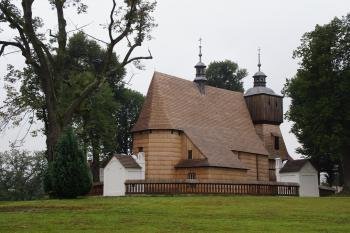Hubert 3.0
Wooden Churches of Southern Malopolska
Wooden Churches of Southern Malopolska (Inscribed)

Three separate World Heritage sites in one region with a total of thirty individual sites - much ado just about wooden churches? At least these were my thoughts before we planned our trip to Lesser Poland and Slovakia in August 2014. But while reading the nomination documents and viewing the pictures to decide which of the sites might be worth a visit, I started to change my mind. And after we visited the first two or three, these lovely wooden churches had won me over. Finally, we visited eighteen of them, several more than we initially had planned.
All churches have in common a striking architecture and an enchanting interior with colourful paintings on the walls and ceilings. And they are located in beautiful rural settings, behind trees and surrounded by meadows. But this also means that most of them are in a rather remote area, thus I would endorse the recommendation by Clyde to use a navigation system and to previously check the coordinates in Google Maps or Google Earth.
Despite the obvious similarities between the three nominations there are distinct differences in architecture and interiors. The characteristic features of the churches included in the Southern Malopolska WHS: the nave and the chancel have a tall gable roof with a small bell-turret on top, on the west side is a tower with the main portal, and most of the churches are surrounded by (open) arcades called sobots. The tower is not or only marginally higher than the main roof.
We had different experiences in terms of access to the interior, entrance fee and photo permit. In Poland, the entrance was free in most cases, sometimes we had to pay a fee for taking photos, but we always made a donation or bought a booklet or a postcard, I think that's appropriate, in particular because I took a lot of photos.
A few comments on the individual sites:
Lipnica Murowana: very fine paintings in pale colours, predominantly in yellow and white, e.g. The Last Supper and The Last Judgement in the chancel, the Ecce Homo scene and other biblical scenes in the nave; the only church without a tower, completely surrounded by open arcades; the church was open, there was a guided tour when we arrived
Debno Podhalanskie: the interior is densely covered with paintings and geometrical and floral motifs; a beautiful Gothic altarpiece; regular opening times, it was the most crowded church we visited, several tour groups and minibuses, probably because it is in a major tourist area (near Dunajec gorge and Zakopane); no photos allowed
Binarowa: the church was closed, only the porch was open, but we were able to see the rear part through a lattice door; rich decorations on the walls and ceiling; we tried to call the phone number that was indicated at the door, but we got no connection
Haczów: open, though nobody was around; the largest of the wooden churches in Poland, extended by a chapel and completely surrounded by open arcades; the interior was less impressive compared to other churches
Blizne (photo): my favourite among the sites of this WHS; the exterior is very harmonious, surrounded by a wooden fence with several stone shrines, no arcades; the interior is entirely covered with paintings and floral motifs even the pews and the tiny pulpit; the church was closed when we arrived, but other visitors already had called the phone number of the rectory, and a few minutes later a friendly young man (the priest himself?) came and opened the door; no photos allowed, but we took a few photos through the lattice door.
Sêkowa: the special feature of the exterior is the open ground floor of the tower; the interior has only little decoration, because the church was destroyed during WWI and the interior fittings and the wood of the walls with the original paintings were lost; it was closed when we arrived, but a kind man from the neighbouring house organized the key for us.
The WHS comprises six churches from the 15th and 16th century, three others were rejected. According to the advisory body evaluation mainly because they are more recent, from the 17th and 18th centuries. However, the inscribed churches underwent several changes over the centuries, the towers and arcades are later additions and also several of the paintings and sculptures are Baroque. Of the rejected churches we visited the one in Orawka, it was on our route from Slovakia to Krakow, the only substantial difference to the inscribed sites was the addition of a brick-built chapel.
Comments
No comments yet.
